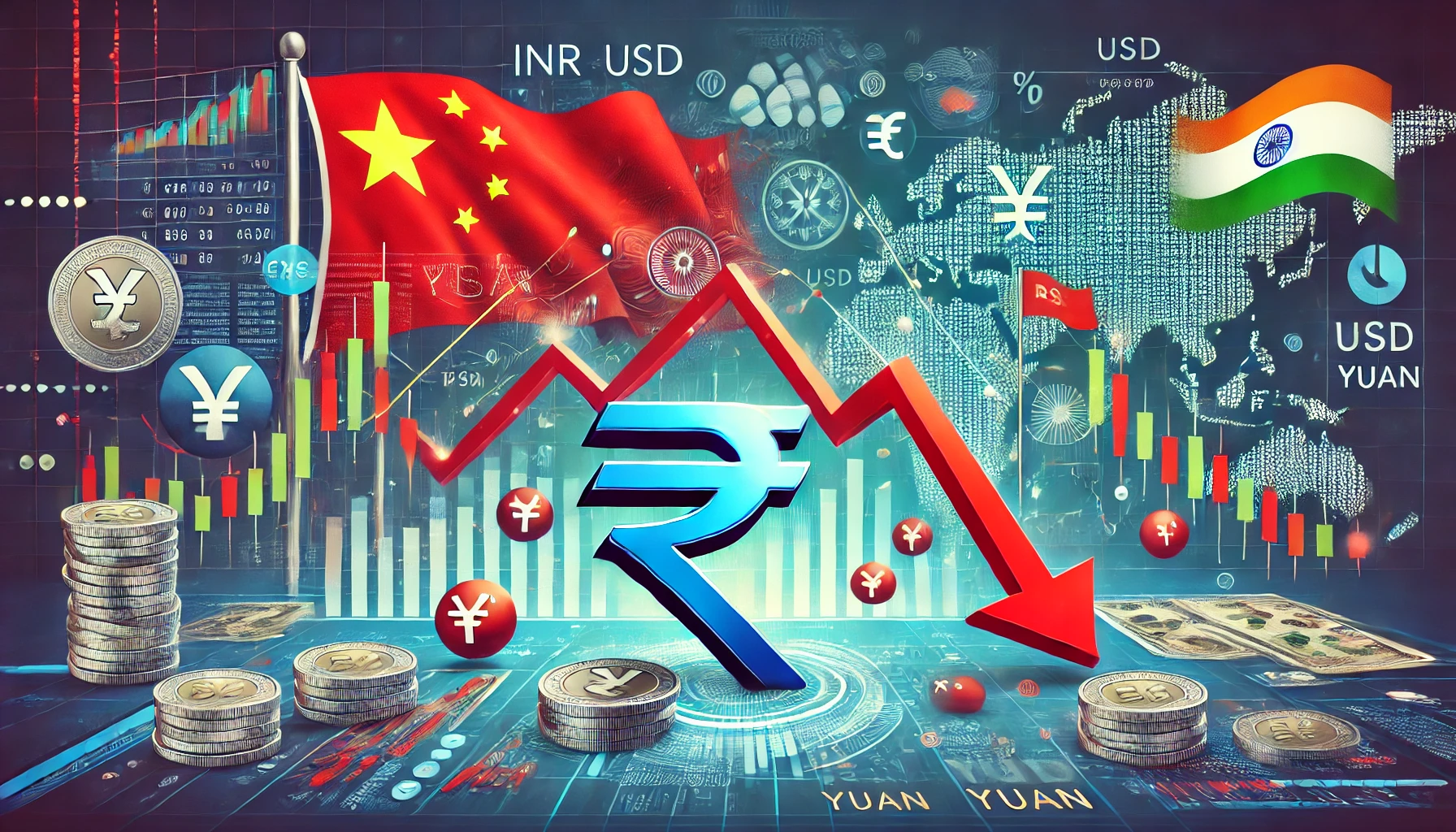Why the Indian Rupee Is Set for Further Decline: Analyzing the Forces Behind Its Depreciation
The Indian Rupee (INR) has been facing increasing pressure in recent years, and it appears to be on track for further decline. As foreign investment shifts to China and global economic factors continue to weigh heavily on India’s currency, the future outlook for the Indian Rupee is uncertain. Experts predict that the Rupee may experience more losses in the coming months, exacerbated by factors such as reduced foreign investment in India and currency depreciation.
In this blog, we’ll explore the underlying reasons behind the Indian Rupee’s decline, compare it against other global currencies like the Chinese Yuan and US Dollar, and examine how shifting foreign investments are reshaping India’s economic landscape. The impact of global economic dynamics and capital flows are crucial to understanding what lies ahead for the Rupee.
Indian Rupee Decline: What’s Driving the Depreciation?
The Indian Rupee’s performance has been lackluster over the past few years, and 2024 has been particularly challenging. The currency has shifted from being one of the strongest performers in Asia to one of the worst(Hindustan Times). Several internal and external factors have contributed to this currency depreciation in India, making it more difficult for the country to maintain economic stability.
Impact of Rising Oil Prices on INR
One of the primary reasons for the Indian Rupee’s decline is rising crude oil prices. India imports around 80% of its oil, and any fluctuation in global oil prices has a direct impact on the country’s current account deficit. Higher oil prices mean increased demand for foreign currency (typically the US Dollar), putting further downward pressure on the INR to USD exchange rate(Hindustan Times).
As oil prices rise, India’s trade deficit widens, leading to a negative balance of payments. This situation has a cascading effect on the Rupee, as the increased demand for foreign currencies drives the value of the INR down.
Inflation and Economic Uncertainty
Inflationary pressures have also taken a toll on the Indian Rupee performance. High inflation erodes purchasing power and makes Indian goods less competitive on the global market. The currency depreciation in India is further compounded by lower growth prospects, leading to reduced investor confidence. The Indian economy has faced headwinds in terms of slower-than-expected recovery from the COVID-19 pandemic, and the Rupee has become a casualty of these challenges.
Foreign Investment in India 2024: Shifting to China
Another major factor impacting the Indian Rupee’s decline is the shift of foreign institutional investors away from India and toward China. While India was once seen as a promising destination for foreign capital, the investment shift to China has been accelerating in recent years. This shift is largely due to China’s aggressive policies aimed at attracting foreign investments and its better control over inflation and economic growth(Hindustan Times).
Why Foreign Investors Are Choosing China Over India
Foreign investors are increasingly moving their capital to China because of its strong economic fundamentals, robust infrastructure, and larger market size. China has consistently positioned itself as a more attractive destination for foreign investment, offering greater opportunities for returns. As a result, India is losing out on crucial foreign institutional investors who could have bolstered the country’s economic standing.
This investment shift to China weakens the Rupee further by reducing capital inflows into India. Foreign investments play a significant role in supporting the Indian economy, and a reduction in those investments puts additional pressure on the country’s balance of payments, which leads to further currency depreciation.
Impact on the Indian Economy
The loss of foreign investments has broader implications for India’s economic growth. With reduced capital inflows, the government has fewer resources to fund infrastructure projects and social programs. This investment shift to China is also likely to reduce India’s long-term economic potential, as industries like manufacturing and technology could stagnate without the necessary funding(Hindustan Times).
Indian Rupee vs. Chinese Yuan and Global Currencies
The Indian Rupee vs. Chinese Yuan comparison is critical in understanding the shifting economic dynamics between these two Asian powerhouses. The Chinese Yuan has been strengthening against the Rupee, as China’s economic growth and policy stability attract more investors.
How Does INR Compare Against the Yuan and USD?
The INR to USD exchange rate has been under pressure for some time, largely because of the impact of the US dollar on INR. The US Dollar has strengthened against many global currencies, including the Rupee, due to the Federal Reserve’s interest rate hikes aimed at controlling inflation in the US. These higher rates make the dollar a more attractive investment, drawing capital away from emerging markets like India.
The comparison between the Indian Rupee vs. Chinese Yuan further reveals how much more stable the Yuan has been in recent years. While India has struggled with inflation and growth concerns, China has managed to maintain a steady currency despite global economic challenges. As a result, investors view the Yuan as a safer bet, leading to further investment shift to China.
The Impact of US Dollar on INR
The impact of the US dollar on INR cannot be understated. As the US Federal Reserve tightens its monetary policy, the Rupee weakens due to increased demand for the US Dollar. This situation exacerbates the problems India faces, as a weaker Rupee makes it more expensive to import goods and repay foreign debt(Hindustan Times).
The strength of the US Dollar has a domino effect on the Indian economy, particularly in sectors like manufacturing and imports, which depend heavily on foreign currencies. The Indian Rupee’s decline against global currencies, including the Yuan and the Dollar, highlights the increasing challenges India faces in managing its foreign exchange reserves.
Long-Term Outlook: Will the Rupee Recover?
As we move further into 2024, the future of the Indian Rupee remains uncertain. Factors such as rising inflation, oil prices, and capital outflows continue to drag the currency down. However, there are potential opportunities for recovery if India can implement policies to improve its investment climate and attract more foreign capital.
Strategies for Boosting the Rupee
- Encouraging Foreign Investment: India needs to offer more incentives for foreign institutional investors, particularly in sectors like technology and infrastructure. Improving ease of doing business and reducing regulatory hurdles could attract more foreign capital.
- Strengthening Economic Fundamentals: By focusing on reducing inflation and boosting economic growth, India can make the Rupee more attractive to investors. This would require a combination of fiscal and monetary policies aimed at stabilizing the economy.
- Diversifying Trade Relationships: India should look to diversify its trade partners and reduce its dependence on oil imports by investing in renewable energy. This would help manage the current account deficit and reduce the country’s vulnerability to global oil price fluctuations.
Conclusion: Understanding the Forces Behind the Indian Rupee’s Decline
The Indian Rupee’s decline is the result of a complex mix of internal and external factors, from rising oil prices and inflation to the investment shift to China. As the Indian Rupee vs. Chinese Yuan comparison reveals, the Rupee is losing ground in the global economy, putting additional pressure on India’s foreign exchange reserves.
While the challenges are significant, India has the potential to reverse these trends by implementing policies to attract more foreign investment and stabilize its economic fundamentals. However, the road to recovery will be long, and the impact of the US dollar on INR will continue to play a major role in shaping the Rupee’s future.
For more insights on global currencies and economic trends, visit Regent Studies. You can also check out this detailed report on the future of the Indian economy from The Economic Times.



